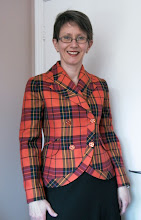
After I figured out a few problems* with my new (to me) sewing machine the Pfaff quilt expression 4.0, otherwise known as "the beast" because it's so big and powerful, I had a lot of fun making this dress. Too bad the weather is not cooperating and I feel it's just too cool to even put it on for some quick modeled photos. This is a hot weather dress. Maybe later.
This is an "easy" pattern from McCalls. I'm never sure what criteria pattern companies use to decide if a pattern is "easy". Although this dress has only two "main" pattern pieces and no darts, I'm not sure I agree with McCalls' rating. It has a proper shirt collar (two pieces with a stand) and a partial placket with a curious pleat built into the bottom end of it. These are at least moderately difficult to sew because they really demand very precise sewing.
But I own David Page Coffin's book on Shirtmaking (a valuable resource) and - as I told the lady behind the counter at Fabricland tonight (who unaccountably assumed that I needed help choosing my pattern size) - 40+ years of sewing experience. I laugh at shirt collars and applied plackets.
I used David P.C.'s instructions (p. 100 in his book) which help me avoid the dreaded nasty blob of fabric lumpiness just at the point where the collar stand meets the placket and is completely finished by machine.



After I finished sewing this, I read on the
McCalls blog that the bottom bit of the placket is not supposed to be sewn down. Oops. Maybe next time I should have a peek at the instructions.
I checked all the pattern reviews on
PR looking for some indication about the hemline. This pattern has three different hem lengths/styles. I had it in mind to make the hem from view D but I think the technical drawing isn't quite accurate. As drawn on the pattern tissue, the shirt tails are much more exaggerated. Several reviewers noted that the hemline was very short at the side seams - 6.5" or 17cm shorter, in fact - and that it felt uncomfortable as a result.

For safety's sake I decided to cut the hem for view C and decide on shaping later. I'm glad I did. When I tried the dress on I realized that it was a nice knee length and that I didn't want it to be any shorter. To keep the shirtiness of it I left slits at the side seams and sewed in a little bias triangle reinforcement, mimicking something that is sometimes done in nice men's shirts.
The fabric is an embroidered mid-weight cotton/linen (I think). From deep stash. It has a nice drape for this dress, although I am thinking of doing it again in a stiffer cotton (African print).
My only complaint about this pattern is that the arm openings are quite deep. If (when) I make this again I will raise the opening by at least 1cm.
* Problems with the 4.0 were:
1. In stitching down the placket, I was getting tension issues. This machine has electronically set tension and I had not had any problem before even when sewing through multiple layers of quilting cotton (that
Bionic Gear Bag project, remember it?). I had a hunch that the tension might regularize if I inserted a slightly bigger needle. It did. Problem solved!
2. I had a thread jam and the built-in thread cutter simply stopped working. I went on line and came across a clue as to how to reset the sensor. I tried it. It worked. You have no idea how happy I was!
For posterity, here is a picture of what needs to be adjusted, if you have this machine and encounter the same problem. Take off the throat plate, get something pointy and use it to push the little nut at upper left as far to the left in its channel as it will go. I don't think I had to move it more than about 1mm, and this was messing up the cutting completely. Problem solved!
I love this machine, especially the buttonholes...
There are more shirtdresses in my near future.

 I so enjoyed sewing McCalls 6885 that when McCalls patterns were on sale recently, I hopped over to my local store and picked up a couple more. I bought 6696 even though it's a fussy pattern (inset waist band, back gathers) partly because I love the look of the eyelet version with the bicycle and partly because I think the slip pattern could be useful. But I bought 7351 for the slim lines of view A and decided to make it first.
I so enjoyed sewing McCalls 6885 that when McCalls patterns were on sale recently, I hopped over to my local store and picked up a couple more. I bought 6696 even though it's a fussy pattern (inset waist band, back gathers) partly because I love the look of the eyelet version with the bicycle and partly because I think the slip pattern could be useful. But I bought 7351 for the slim lines of view A and decided to make it first.

 It was an enjoyable sewing experience. Substantial cotton is so well behaved! For some reason the buttonholes had to wait but I charged up the beast and made them today. That machine does buttonholes like a champ! There are 8 because stash had only 8 of the perfect buttons.
It was an enjoyable sewing experience. Substantial cotton is so well behaved! For some reason the buttonholes had to wait but I charged up the beast and made them today. That machine does buttonholes like a champ! There are 8 because stash had only 8 of the perfect buttons.















